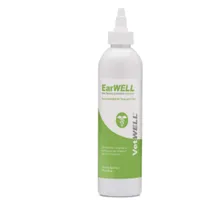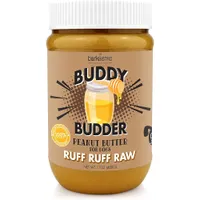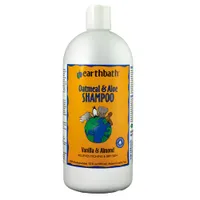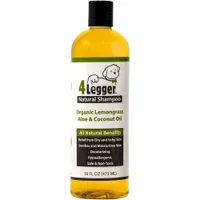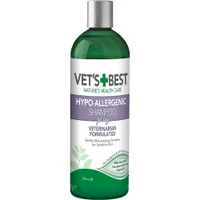How to give a dog a bath: A vet’s guide
Knowing how to give a dog a bath properly can make it a better experience for both you and your furry friend
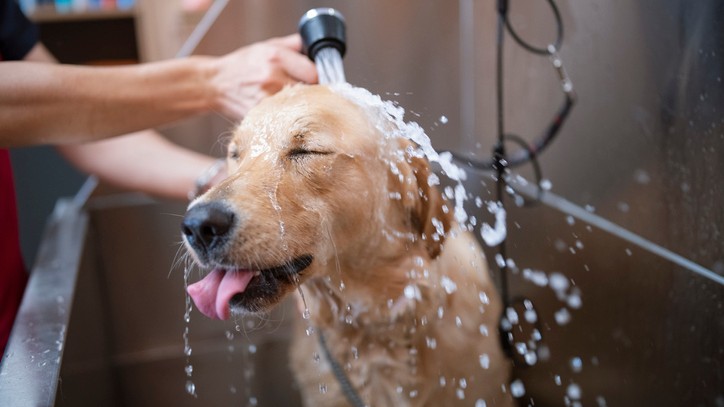
If your young puppy has just got back from their first muddy walk, you might be wondering how to give a dog a bath. Fortunately, it’s a relatively straightforward process, if you have prepared correctly.
Selecting the best dog shampoo for your pup – and possibly pairing it with one of the best dog conditioners – will make the process much easier. So too will ensuring you have you have all the necessary supplies to make bathing your dog a breeze. Additionally, devote some time to thinking about how you can make bath time as stress-free and rewarding for your dog as possible, particularly if your dog hates baths.
Read on for top tips on how to keep your canine companion calm during their bath time, as well as providing a step-by-step guide to bathing your dog so that each and every time will be a success.
How to bath a dog: Step-by-step
Once you have decided where you are going to bathe your dog, be sure that you have all the supplies you will need within arm’s reach. Include shampoo, conditioner (if recommended by your vet), towels, and some of the best dog treats.
If you are bathing your dog in a sink or bathtub, consider using a no-skid mat to provide comfortable footing for your dog. Taking a few minutes to prepare in advance will make bath time less stressful, while also decreasing the likelihood that you have to step away from your dog during the bath.
How to give a dog a bath: Step-by-step

1. Soak your dog's coat
Bathing your dog is similar to washing your own hair. First, soak your dog’s coat thoroughly in water. Try to avoid getting water in your dog’s eyes and ears. Water in the eyes can be irritating to your dog. Water down in the ear canals can increase the likelihood of your dog developing an ear infection.
2. Apply a small amount of shampoo
Once your dog’s coat is thoroughly soaked with water, apply a small amount of shampoo. Depending on your dog’s size and coat length, you may need a dime-sized to silver dollar-sized amount of dog shampoo.
Get the best advice, tips and top tech for your beloved Pets
Work this shampoo into a lather and massage it into your dog’s coat, including the entire body and even the areas between the toes. Depending on how dirty your dog is, you may choose to do a brief rinse mid-bath and repeat the entire scrubbing process a second time, to remove all dirt and oil from your dog’s coat. Be careful to keep shampoo out of your dog’s eyes and ears during this process.
3. Examine their skin
Bathtime is an excellent opportunity to carefully look over your dog’s skin, because you will have your hands all over your dog as you scrub them. Take note of any new lumps or bumps, while also looking for wounds or other skin lesions. If you see anything that is new or concerning, contact your vet to schedule a thorough physical examination.
4. Rinse thoroughly
After bathing, rinse them thoroughly to remove any shampoo residue. This residue can cause skin irritation. This skin irritation can lead to itching, redness, and hot spots. Finally, allow your dog to shake off thoroughly. This will remove much of the water from their coat. Once they have shaken several times, you can towel-dry your dog.
If your dog has long hair, you should comb their hair thoroughly after bathing. Consider using a hair dryer to help dry the coat more quickly and prevent tangling.
5. Consider an ear cleaner
If your dog is prone to ear infections or you think they may have ended up with water in their ears during the bathing process, flush the ears thoroughly with ear cleaner. Cleaners can be purchased over-the-counter, but it’s best to talk to your veterinarian first because they may have a specific recommendation for your dog. Cleaning a dog’s ears after a bath will help remove moisture from the ears, reducing the risk of infection.
Vetwell Ear Cleaner for Dogs and Cats | Amazon
This veterinary formula cleans and deodorizes your dog’s ears to help eliminate wax build-up.
How to help your dog enjoy baths
You will give your dog many baths over their lifetime. Therefore, it will probably pay off to make a conscious effort to make bath time as fun and rewarding for your dog as possible. If your dog loves baths and sees them as a pleasant experience, it is less likely that you will have to chase him around the house when it’s time for a bath.
A dog that enjoys baths is also less likely to try to escape from you during bathing, making it less likely that your dog will injure themselves in the bathtub and less likely that you will become scratched while trying to restrain your dog.
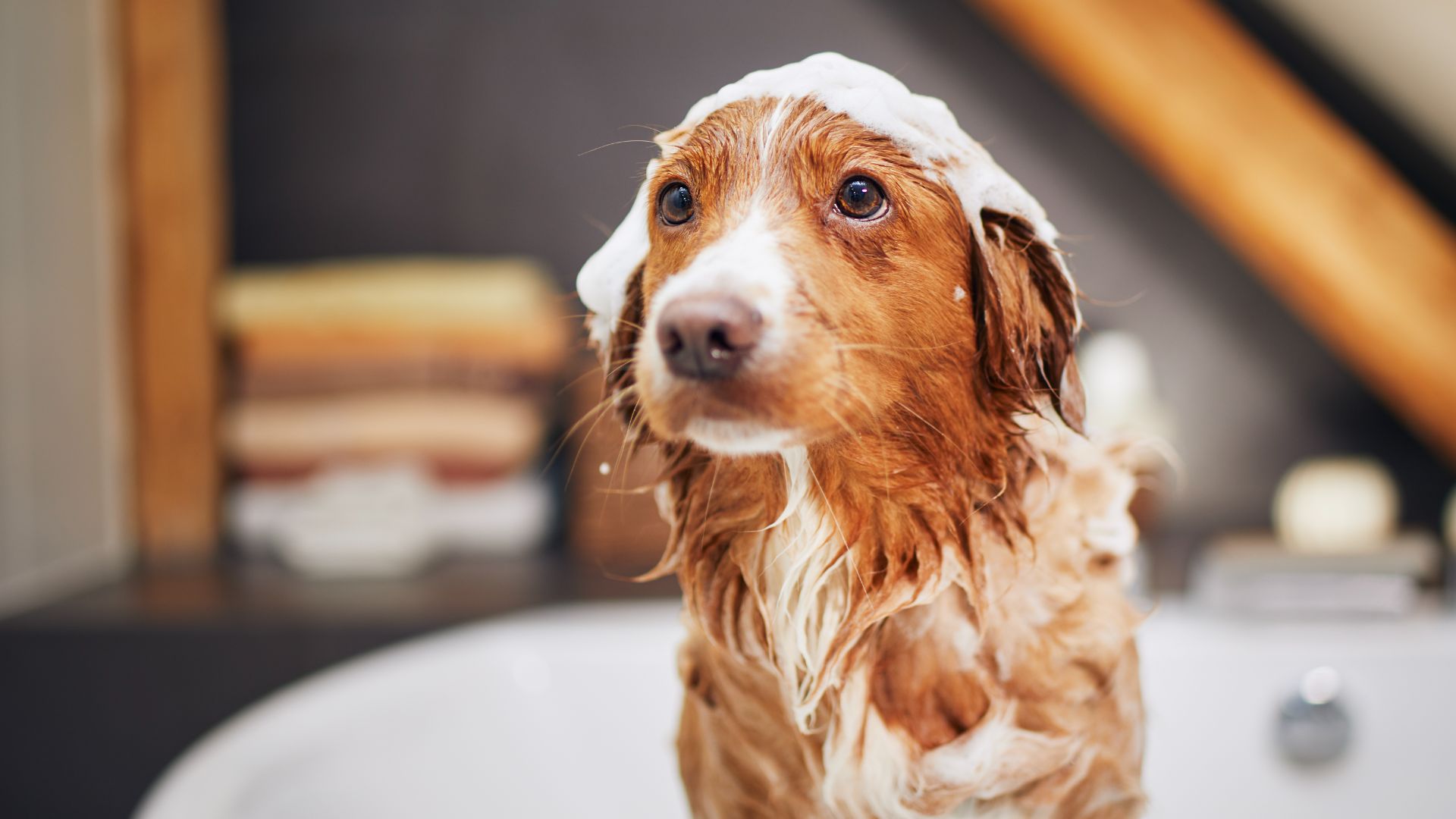
Use food as motivation
Dogs are often motivated by food, making treats an easy way to turn a potentially negative experience (like a bath) into a pleasant experience. Select a treat that your dog loves and offer your dog frequent treats throughout their bath, especially when they are being well-behaved and cooperative.
Try to avoid giving treats when your dog is trying to escape or showing other undesired behaviors, because you don’t want to inadvertently reward uncooperative behavior!
If you use a bathtub for your dog’s baths, consider smearing peanut butter on the edge of the tub at your dog’s eye level (or on a lick mat with suction pads like this one from Amazon). Not only will this provide your dog with constant treats and a positive experience, most dogs will stand relatively still while licking the peanut butter. This will make bath time easier for both of you!
Note: Avoid using sugar-free peanut butter, because it may contain a substance called xylitol that is toxic to dogs.
These lick mats have suction pads so you can stick them to the side of your bath.
Buddy Budder Dog Peanut Butter | Amazon
This peanut butter is made especially for dogs, making it totally safe!
Preparation is key
While you may think you know how to give a dog a bath, it pays to take time to give the issue some conscious thought. Prepare your bath location and ensure that you have all of the necessary supplies before starting.
Give some consideration to how you can make the experience as pleasant as possible for your dog. These simple steps can make bathtime more pleasant for both you and your dog.
How do I choose the right shampoo?
Before bathing your dog, you will need to select a shampoo for your dog’s coat type. Use a pet shampoo that is made specifically for dogs. While you might think that using a human shampoo on dogs would be gentle enough for your canine companion, many human shampoos are far too harsh for a dog’s skin and coat. Even baby shampoo on dogs should be avoided.
Human skin has a lower pH than dog skin, so human shampoo is often too acidic for a dog’s skin and coat. Humans also have thicker skin than dogs, so shampoos that are made for thick human skin can damage a dog’s thin skin, especially when used repeatedly over time.
Earthbath Oatmeal and Aloe Natural Pet Shampoo in Vanilla and Almond | Amazon
This soap-free, pH-balanced shampoo contains plant-derived cleansers. A cruelty-free formula with no sulfates or parabens, this shampoo was awarded best overall in our best dogs shampoos guide.
How to wash a dog with a skin condition
If your dog has a history of skin conditions, such as allergies, ask your veterinarian to recommend the best shampoo for your dog. Your veterinarian may select a prescription shampoo for your dog. Prescription shampoos often contain topical antihistamines and antiseptics, intended to treat or prevent skin inflammation as well as bacterial and/or yeast infections.
If your dog doesn’t need a prescription shampoo, ask your veterinarian which features would benefit your dog in an over-the-counter dog shampoo. For example, many dogs with skin allergies or especially sensitive skin respond well to a soothing, soap-free, aloe and oatmeal-based shampoo. Dogs with healthy skin and a healthy coat may do well with nearly any over-the-counter shampoo, so you can use a bit of trial and error to find the shampoo that leaves your dog with the softest and best-smelling coat possible.
If you suspect your dog may be allergic to some products, ask your vet or read up on dog shampoo allergies.
4-Legger Natural Dog Shampoo | Amazon
This hand-crafted, organic formula uses essential oils and is gentle on canine skin. It's concentrated, too – so a little goes a long way.

Should I use a flea and tick shampoo for dogs?
In general, flea and tick shampoos should be avoided on dogs. At their best, they tend to be ineffective at controlling parasites and therefore a waste of your hard-earned money. At their worst, they can cause significant skin irritation, especially in dogs with sensitive skin.
If you are concerned that your dog may have fleas or ticks, talk to your veterinarian about prescribing the best flea treatment for dogs. A long-acting flea and tick preventative will be far more effective than flea and tick shampoo, while also being much more gentle on your dog’s skin and coat.
Vet Best Hypoallergenic Shampoo | Amazon
This gentle, soap-free formula helps soothe dry, brittle and itchy skin and can be used alongside other treatments.

Should I bath my dog indoors or outdoors?
An important part of knowing how to give a dog a bath is deciding where you are going to bathe your dog. Small dogs are often bathed in their owner’s bathtub or kitchen sink. If you have a larger dog and the outside temperature is above roughly 80°F, you can bathe your dog outside.
Bathing your dog outside can offer several advantages. First, your dog will not shake water all over your home, cutting down on your clean-up time. You also will not have to clear dog hair from your bathtub drain or risk clogging your drains.
Finally, you can even take your dog for a walk in the sunshine to help them dry off. If the weather or even the water from your hose is cold, however, even a large dog should be bathed indoors. You don’t want your dog’s bath to be uncomfortable or risk hypothermia.
Wondering how often you should bathe a puppy? This feature is worth the read.

Bethany is an experienced writer who has been writing across the pets and equestrian sector for eight years.
Dr. Barnette is a graduate of the University of Florida, where she received both her B.S. in Zoology and her Doctor of Veterinary Medicine (DVM). She has 15 years of clinical experience as a small animal veterinarian, treating dogs, cats, and occasional exotic patients. She now works as a freelance veterinary writer, creating educational content for veterinarians, veterinary team members, and dedicated pet owners. Dr. Barnette lives in southwest Florida with her husband and daughter (plus two cats, a dog, and a rescued dove!) and enjoys kayaking, biking, and hiking. Learn more about Dr. Barnette at www.linkedin.com/in/catherinebarnette.
- Bethany StoneFreelance Writer
